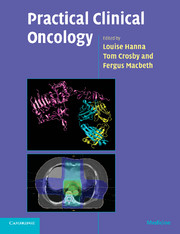Book contents
- Frontmatter
- Contents
- List of contributors
- Preface
- Acknowledgements
- Abbreviations
- 1 Practical issues in cytotoxic chemotherapy usage
- 2 Biological treatments in cancer
- 3 Hormones in cancer
- 4 Radiotherapy planning
- 5 Research in cancer
- 6 Oncological emergencies
- 7 Palliative care
- 8 Head and neck
- 9 Oesophagus
- 10 Stomach
- 11 Liver, gallbladder and biliary tract
- 12 Exocrine pancreas
- 13 Colon and rectum
- 14 Anus
- 15 Gastrointestinal stromal tumours
- 16 Breast
- 17 Kidney
- 18 Bladder
- 19 Prostate
- 20 Testis
- 21 Penis
- 22 Ovary
- 23 Body of the uterus
- 24 Cervix
- 25 Vagina
- 26 Vulva
- 27 Gestational trophoblast tumours
- 28 Lung
- 29 Mesothelioma
- 30 Soft tissue and bone tumours in adults
- 31 The lymphomas and myeloma
- 32 Central nervous system
- 33 Skin cancer other than melanoma
- 34 Melanoma
- 35 Thyroid
- 36 Neuroendocrine tumours
- 37 Cancer in children
- 38 Cancer of unknown primary
- 39 The use of radiotherapy in the treatment of benign conditions
- Multiple choice questions
- Multiple choice answers
- Index
- References
20 - Testis
Published online by Cambridge University Press: 23 December 2009
- Frontmatter
- Contents
- List of contributors
- Preface
- Acknowledgements
- Abbreviations
- 1 Practical issues in cytotoxic chemotherapy usage
- 2 Biological treatments in cancer
- 3 Hormones in cancer
- 4 Radiotherapy planning
- 5 Research in cancer
- 6 Oncological emergencies
- 7 Palliative care
- 8 Head and neck
- 9 Oesophagus
- 10 Stomach
- 11 Liver, gallbladder and biliary tract
- 12 Exocrine pancreas
- 13 Colon and rectum
- 14 Anus
- 15 Gastrointestinal stromal tumours
- 16 Breast
- 17 Kidney
- 18 Bladder
- 19 Prostate
- 20 Testis
- 21 Penis
- 22 Ovary
- 23 Body of the uterus
- 24 Cervix
- 25 Vagina
- 26 Vulva
- 27 Gestational trophoblast tumours
- 28 Lung
- 29 Mesothelioma
- 30 Soft tissue and bone tumours in adults
- 31 The lymphomas and myeloma
- 32 Central nervous system
- 33 Skin cancer other than melanoma
- 34 Melanoma
- 35 Thyroid
- 36 Neuroendocrine tumours
- 37 Cancer in children
- 38 Cancer of unknown primary
- 39 The use of radiotherapy in the treatment of benign conditions
- Multiple choice questions
- Multiple choice answers
- Index
- References
Summary
Introduction
The treatment of testicular cancer is a success story for oncology, with high cure rates even for patients with advanced metastatic disease. The management has changed little over the past 20 years, there is a high degree of consensus about treatment, and standard protocols are well developed. Nonetheless, patients with testicular cancer are best managed by specialised multidisciplinary teams.
Range of cancers
The range of testicular cancers is shown in Table 20.1.
Germ cell tumours
Incidence and epidemiology
The annual incidence of germ cell tumours in the UK is approximately 800 cases. Germ cell tumours are the most common malignant tumours that occur in men between the ages of 25 and 35; there is a second peak between the ages of 55 to 65 years. The reason for the rapid rise in incidence in the Western world is not known. Theories range from the impact of environmental oestrogens, related to oral contraceptive use, to the increased scrotal temperatures resulting from the use of disposable diapers in infancy.
Risk factors and aetiology
Both genetic and epigenetic factors probably affect the development of testicular cancer. There is certainly a genetic component, with around 2% of cases reporting an affected first-degree relative, and a ten-fold increased relative risk in a brother of an affected relative. However, a range of conditions associated with subnormal testicular development, such as testicular maldescent, Klinefelter's syndrome, Down's syndrome and subfertility, are also associated with a higher risk of cancer.
- Type
- Chapter
- Information
- Practical Clinical Oncology , pp. 240 - 251Publisher: Cambridge University PressPrint publication year: 2008

